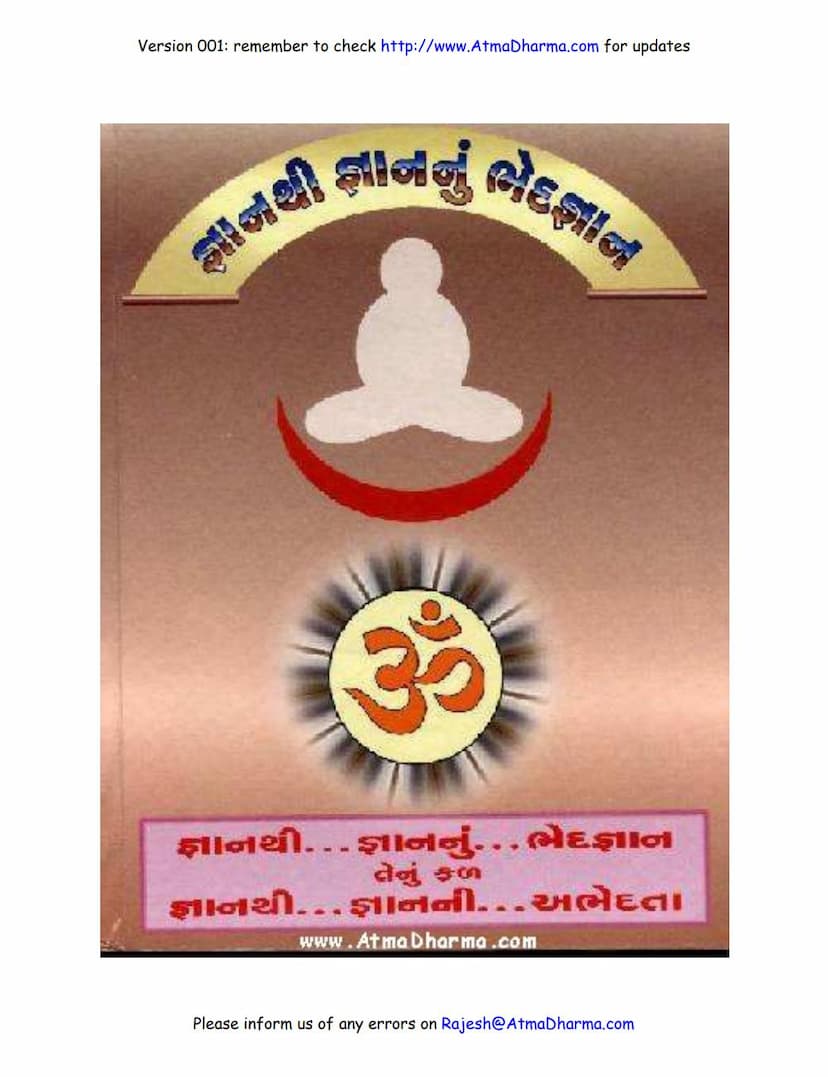Gyanthi Gyannu Bhedgyan
Added to library: September 1, 2025

Summary
The book "Gyanthi Gyannu Bhedgyan" (Sacred Knowledge of the Distinction of Knowledge) by Lalchandra Pandit, published by Digambar Jain Kundamrut Kahan, is a discourse that delves into the core principles of Jain philosophy, particularly focusing on the nature of knowledge, the self, and liberation. The text is based on the profound teachings and discourses of Pujya Shri Kanji Swami, revered as a spiritual luminary, and is further elucidated through the insightful interpretations of Pujya Shri Lalchandbhai (affectionately known as "Bhaishri"), a devoted disciple.
The book emphasizes the paramount importance of Bhedgyan (Discernment/Differentiating Knowledge) as the key to spiritual realization and liberation. It systematically breaks down the complex philosophical concepts of Jainism, making them accessible to the seeker.
Here's a comprehensive summary of the key themes and teachings presented in the text:
1. The Nature of Reality and the Self:
- Anekantavada (Non-absolutism): The text implicitly upholds the Jain principle of Anekantavada, acknowledging the multifaceted nature of reality. It encourages understanding concepts from various perspectives to arrive at a comprehensive truth.
- Dravya (Substance) and Paryay (Modality): A core teaching revolves around understanding the distinction between the eternal, unchanging substance (Dravya) of the soul and its transient, ever-changing modalities (Paryay). The soul (Jiva) is described as pure consciousness, inherently possessing qualities like knowledge, perception, bliss, and energy.
- Self-Reliance: The true self is self-existent and self-illuminating. It does not depend on external factors for its existence or knowledge. The pursuit of the self is an inward journey.
2. Bhedgyan (Discriminating Knowledge) as the Path:
- Distinguishing Self from Non-Self: The central theme is the practice of Bhedgyan, which involves rigorously discriminating between the soul (Atman) and the non-soul (Pudgala, karmic matter, body, mind, senses, etc.). This is the foundational step towards spiritual progress.
- Understanding Sensory Knowledge vs. True Knowledge: The text strongly emphasizes that sensory knowledge (Indriya Gyan), which pertains to external objects (sound, touch, taste, smell, form), is not true knowledge. It is considered illusionary (Maya) or an obstacle to the soul's true nature. True knowledge (Atma Gyan) arises from within, from the soul's own pure consciousness, and pertains to the soul itself.
- The Soul's Nature: The soul's true nature is to know, but its object of knowledge is itself. It is not meant to know external objects. Perceptions of external objects through the senses are considered illusory or the result of external influences, not the inherent nature of the soul's knowledge.
- The Illusion of Knowing the External: The text repeatedly clarifies that the soul, by its very nature, does not and cannot know external objects. Any perceived knowledge of the external is either a product of the senses (Indriya Gyan) or a misconception. The soul's knowledge is self-referential.
3. The Nature of Knowledge and Ignorance:
- True Knowledge is Self-Knowledge: The ultimate goal is to realize that true knowledge (Atma Gyan) is the direct experience of the soul's own nature. This is contrasted with sensory knowledge which is external and fleeting.
- Sensory Knowledge as Ignorance: Sensory knowledge, although a perception, is often equated with ignorance (Ajnaan) when mistaken for true self-knowledge. This misconception binds the soul to the cycle of birth and death.
- The Cycle of Action and Reaction: The text elaborates on the subtle workings of karma, emphasizing how actions (karma) and their resultant experiences are not directly caused by external factors but by the soul's own inclinations (kashayas) and the subsequent manifestation of karmic matter.
4. Liberation (Moksha):
- The Path to Liberation: Liberation is attained by shedding all external identifications and attachments, including the mistaken belief in sensory knowledge as true knowledge. It is achieved through constant introspection and the realization of the soul's intrinsic nature.
- The Importance of Detachment: The teachings highlight the necessity of detachment from worldly desires and sensory experiences, as these are seen as impediments to self-realization.
- The Role of Right Faith and Knowledge: Right Faith (Samyak Darshan) and Right Knowledge (Samyak Gyan) are crucial precursors to Right Conduct (Samyak Charitra), which ultimately leads to liberation. Bhedgyan is the essential path to achieving these.
5. Spiritual Practice and Realization:
- Contemplation and Self-Awareness: The text encourages constant contemplation of the soul's true nature and the practice of self-awareness. This is a process of turning inwards, away from external distractions.
- The Role of Gurus and Scriptures: While emphasizing self-realization, the text also acknowledges the guidance of enlightened beings (Gurus) and the wisdom contained in scriptures like "Samaysar" as invaluable aids on the path.
- Living the Truth: The ultimate aim is not just intellectual understanding but the direct, experiential realization of the soul, leading to a state of liberation and eternal bliss.
Metaphorical Language and Examples: The discourses often employ analogies and metaphors, such as the lamp and its light, or the mirror and its reflection, to illustrate the nature of self-knowledge and the distinction between the self and external phenomena. These examples help to simplify abstract spiritual concepts.
In essence, "Gyanthi Gyannu Bhedgyan" is a spiritual guide that illuminates the Jain path to liberation by emphasizing the transformative power of discriminating between the eternal soul and the transient world, and the necessity of cultivating pure self-knowledge through introspection and spiritual practice. The discourses are presented with a profound emphasis on the authority and experiential depth of the teachings, encouraging seekers to internalize and realize these truths.